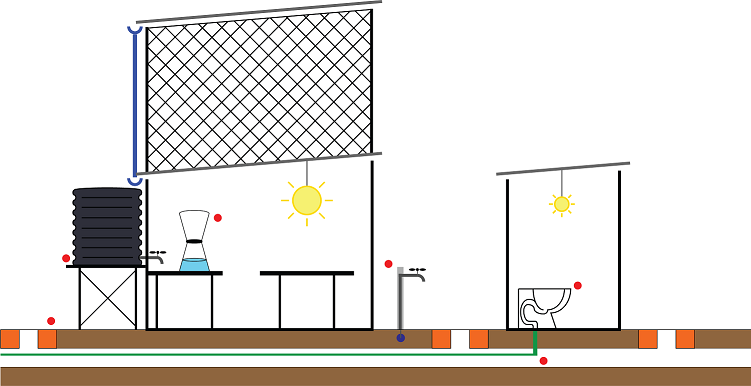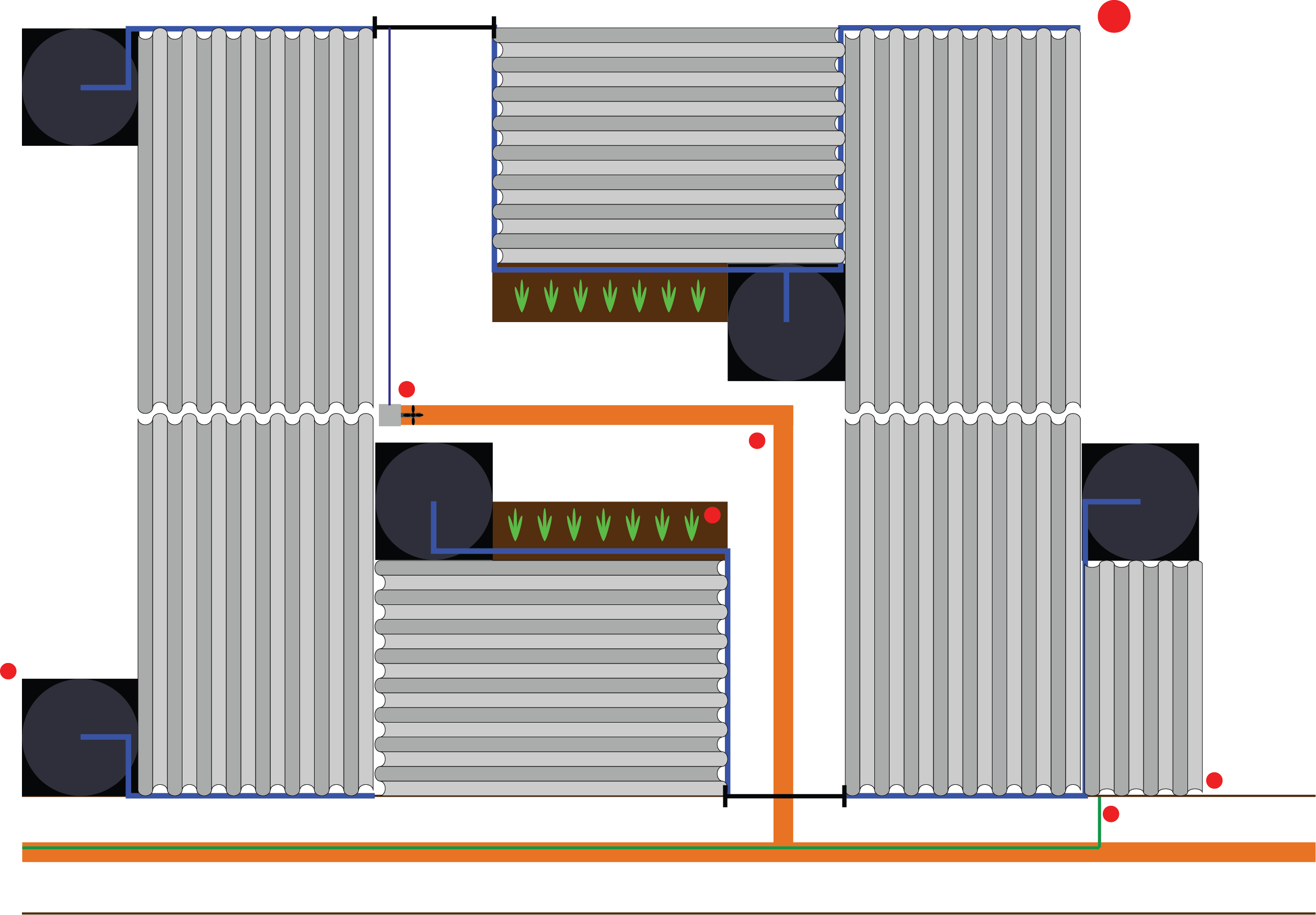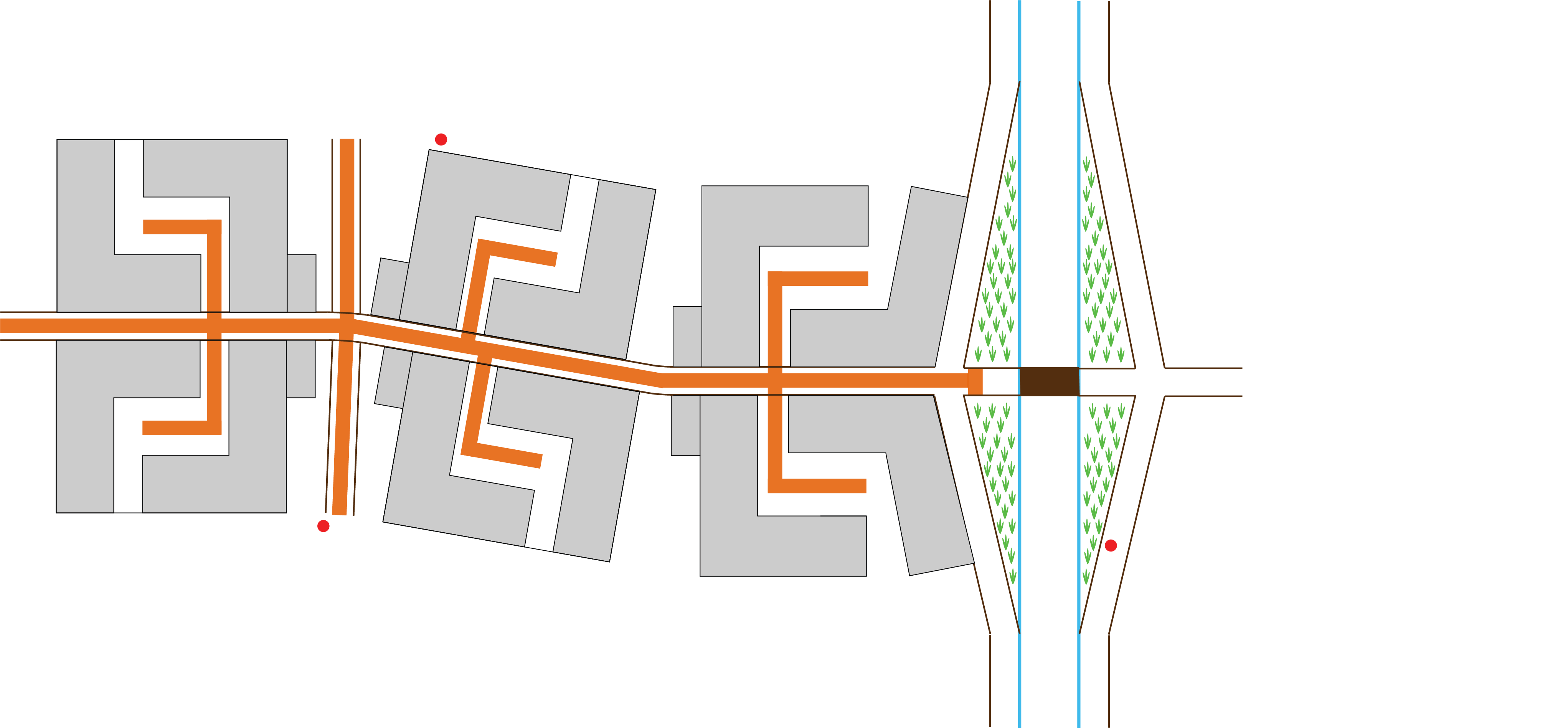The concept design represents a suite of complementary water solutions that addresses water supply, quality and management as well as sanitation. It also represents an idea of a modular superblock housing arrangement, inspired by the Emu ku’emu concept. While the design arrangements and technologies presented below address several water issues within Katanga, each of them also bear an impact on overall affordability.
Click on the red dots in the illustrations to read a description and key benefits of each solution.
Figure 1. Water solutions at the household level
- Pathway drainage culverts
- Rainwater harvesting
- Household water filters
- Connection to piped water
- Urine diverting dry toilets
- Connection to centralised sanitation system
Figure 2. Modular superblock co-housing concept and related water solutions
- Modular superblock
- Water taps
- Pathway drainage culverts
- Urban greening
- Rainwater harvesting
- Shared latrine
- Connection to centralised sanitation system
Figure 3. Modular superblocks and wetland installations in central drainage channel
- Pathway drainage culverts
- Modular superblocks
- Wetland installations
While these solutions have been developed with local implementation in mind, they are not solely limited to Katanga and could be used in any combination in similar contexts within Kampala and beyond.
Rainwater harvesting
Water supply
Kampala’s climate includes high annual rainfall through two rainy seasons. Installation of new sloped, household roofs provides an opportunity to harvest rainwater using gutters and a collection tank. Harvested water can be used for washing, gardening, and other non-potable uses.
- Reduces amount of water purchased from taps or outside sources
- Increases community resilience by providing independent supply of water
- Has high initial installation costs, but low maintenance costs
- Could increase potential for new water-intensive activities such as urban farming
- Does not require coordination with city authorities or organisations for implementation
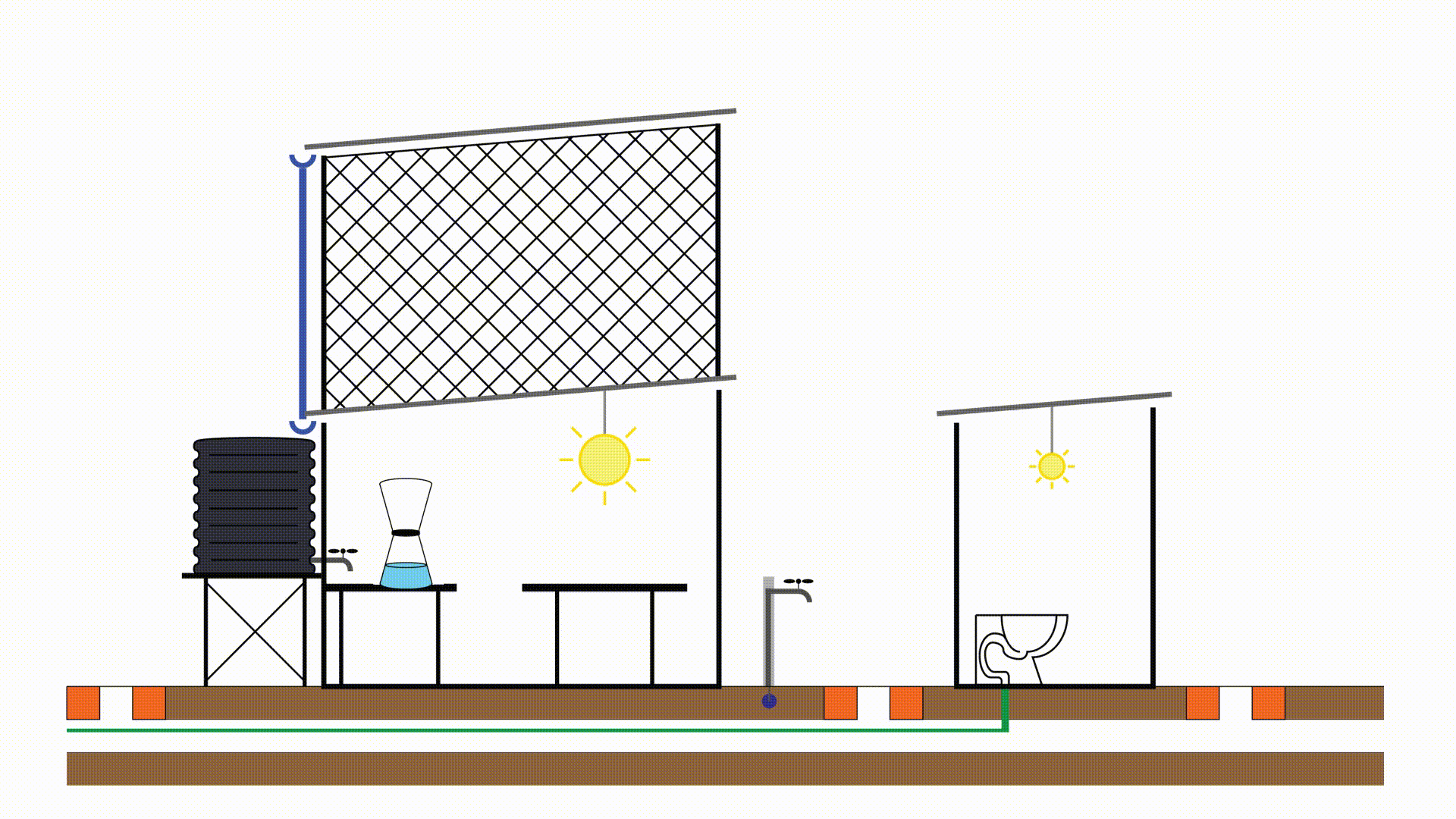
Pathway drainage culverts
Drainage
Formalising the use of main pathways and alleys as drainage channels by installing drainage culverts. This does not obstruct the existing flow of runoff, but contains it underneath the surface. This will also improve the accessibility of Katanga by flattening the uneven ground along the centre of the pathway.
- Reduces flooding and erosion from rain runoff
- Reduces pollution flowing to main channel
- Potential underground channel to house sanitation service lines
- Improves mobility along pathways of Katanga

Household water filters
Water quality
Household-scale water filters, such as the VepoX system, allow families to disinfect water from taps or rainwater harvesting for drinking water.
- Affordable initial product (5 USD/20.000 UGS) and filter replacement costs
- Low maintenance needs of filter replacement every 4 months
- Filters up to one jerrycan (20L) of water in 15 minutes
- Can be used continuously with no limit to use
- Designed to use local materials and address needs of Katanga residents
- Saves fuel and is more reliable than water boiling
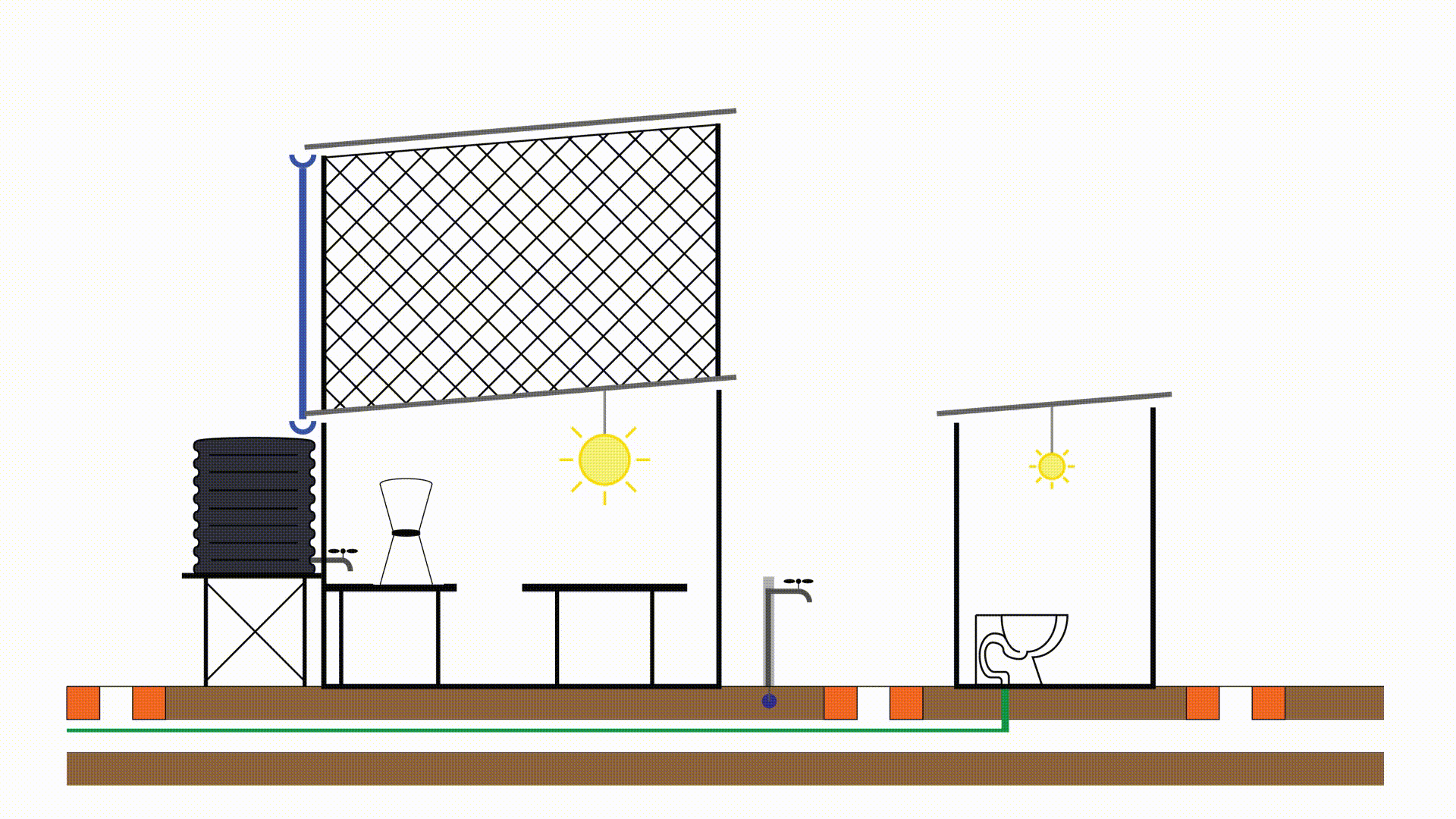
Connection to piped water (Water taps)
Water supply
Connection to the centralized city water supply would allow the installation of meter taps within Katanga. Taps can be installed within each ‘modular superblock’ to reduce the total amount of connections and allow cost sharing between a coalition of 4-6 households.
- Improve access to water for families across Katanga
- Installation costs absorbed by coordinating body, rather than individual households
- Increases resilience of Katanga by reducing reliability on existing sources
- Likely the cheapest option per household when costs are shared
Connection to centralised sanitation system
Sanitation
Connection to the centralised city sanitation and water treatment system would allow for the potential to install low-flush toilets in Katanga. These connections would need to be installed in coordination with city utilities and would remove waste to be treated at the water treatment plant.
- Improve sanitation for families across Katanga
- Installation costs absorbed by coordinating body
Urine diverting dry toilet
Sanitation
Urine diverting dry toilets (UDDTs) are latrine alternatives that separate the collection of urine and solid waste without using water. UDDTs can be constructed with local materials and are suitable for flood-prone areas such as Katanga. The latrines can be installed as part of the ‘modular super-block’ to share costs between a coalition of 4-6 households and reduce the amount of installations.
- Can be constructed and repaired with local materials
- No water use needed
- Small land requirement
- Long service life (as it can be safely emptied)
- Dried waste can potentially be used for fertiliser
- Urine should be diverted through wetland water treatment
- Suitable for flood-prone and high-groundwater areas
- Low odour, making them suitable for use near residences
Pathway drainage culverts
Drainage
Formalising the use of main pathways and alleys as drainage channels by installing drainage culverts. This does not obstruct the existing flow of runoff, but contains it underneath the surface. This will also improve the accessibility of Katanga by flattening the uneven ground along the centre of the pathway.
- Reduces flooding and erosion from rain runoff
- Reduces pollution flowing to main channel
- Potential underground channel to house sanitation service lines
- Improves mobility along pathways of Katanga
Water taps
Water supply
Connection to the centralized city water supply would allow the installation of meter taps within Katanga. Taps can be installed within each ‘modular superblock’ to reduce the total amount of connections and allow cost sharing between a coalition of 4-6 households.
- Improve access to water for families across Katanga
- Installation costs absorbed by coordinating body, rather than individual households
- Increases resilience of Katanga by reducing reliability on existing sources
- Likely the cheapest option per household when costs are shared
Modular superblock
A superblock configuration of houses creates residential courtyard spaces that allows the adjacent families to share facilities. With their common courtyards and shared infrastructure, the superblock concept could allow for the formation of housing cooperatives. This cooperative ownership mechanism could lower the individual cost of access for many services and solutions proposed in Project Amaka.
- Provide private and secure outdoor space for families
- Allow for individual water taps and latrines to service multiple families
- Reduces costs of services and facilities for individual families
- Increases community cohesion and cooperation between neighbors
Connection to centralised sanitation system
Sanitation
Connection to the centralised city sanitation and water treatment system would allow for the potential to install low-flush toilets in Katanga. These connections would need to be installed in coordination with city utilities and would remove waste to be treated at the water treatment plant.
- Improve sanitation for families across Katanga
- Installation costs absorbed by coordinating body
Urban greening
As a dense and unplanned settlement, Katanga is suffering from a severe lack of vegetation or green space. Vegetation provides many environmental and social benefits for communities. The space created by the Emu ku’emu and the superblock courtyards provides an opportunity to increase the amount of trees and vegetation. The courtyards and elevated open space could also support urban gardening. Urban gardening can help promote food security, nutrition and a source of income for residents.
- Societal and health improvements associated with increase in urban greening
- Trees and vegetation help reduce air pollution, water pollution, flooding and erosion.
- Nature-based solutions can help passively increase urban greening
Rainwater harvesting
Water supply
Kampala’s climate includes high annual rainfall through two rainy seasons. Installation of new sloped, household roofs provides an opportunity to harvest rainwater using gutters and a collection tank. Harvested water can be used for washing, gardening, and other non-potable uses.
- Reduces amount of water purchased from taps or outside sources
- Increases community resilience by providing independent supply of water
- Has high initial installation costs, but low maintenance costs
- Could increase potential for new water-intensive activities such as urban farming
- Does not require coordination with city authorities or organisations for implementation
